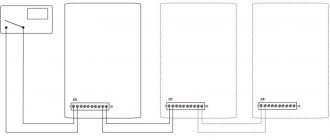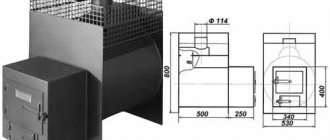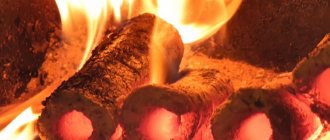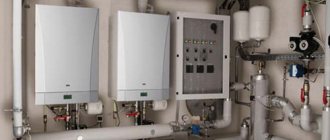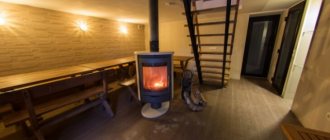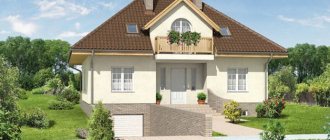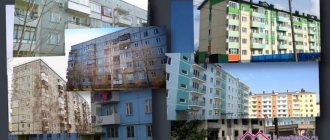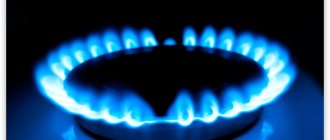It has long been known that ignition from above on different fireboxes - heating stoves, fireplaces, sauna stoves with different chimney heights allows you to get a 100% result, which many people like: it’s easy and quick to get smoke and fire, the firewood sets, no smoke comes into the room, and glass (if it is included in the design) does not smoke, the chimney warms up quickly, and there is no condensation. Ignition from above has been known for a long time. For example, the same candle or match, not to mention the Mayan tribes, who erected pillars, cut them a little on top and set them on fire, and these lanterns burned for a long time and brightly.
When igniting from above, the wood burns more slowly, since only the top part of the stack burns. With bottom ignition, the entire volume burns from bottom to top faster, which is why this method is in demand. In order for the entire stack to burn during top ignition, it is necessary to establish air flow, organize it from the ignition side and so that it passes through the entire thickness of the firewood or coal stack, in which case the flame will engulf the entire firebox, and not just some part of it.
In fact, normal manufacturers practice just this method. The air is preheated and thrown from above. For example, the manufacturer of Keddy fireplace stoves with air supply throughout the entire plane.
How to load fuel and operate the unit correctly
A long-burning unit differs from a traditional furnace by an increased loading volume and limited access of oxygen to the working area.
The operating time of the boiler depends on the amount of fuel loaded, so the firewood is stacked as tightly as possible, without leaving large gaps between the logs. If materials such as peat, fine coal, shavings, sawdust or pallets are used as fuel, then they are poured to the level of the smoke channel without compacting. The necessary compaction of the fuel will be provided by a heavy metal piston. Fuel loading is performed in the following order:
- remove the top cover from the unit;
- remove the air distribution device;
- load the stove to the level of the chimney;
- spray the top layer of flammable material with lighter fluid;
- install an air regulator;
- return the cover to its place;
- A piece of rags soaked in a flammable liquid is thrown inside the air channel.
Steady combustion is accompanied by smoke coming out of the chimney evenly. As the wood burns, the duct pipe moves down. It can be used to judge the remaining operating time of the solid fuel unit.
It is best to light the stove using a rag moistened with a flammable liquid.
During operation, ash and ash accumulate at the bottom of the barrel. It must be said that their quantity does not have any effect on the combustion process. However, fuel combustion products must be periodically removed, since they reduce the thickness of the filling layer. To do this, open the bottom door and scoop out the ash using a regular metal scoop.
When removing ash, leave a layer 10–20 mm thick on the bottom of the oven. This will not have a particular effect on the amount of firewood; however, it will create an excellent heat-insulating cushion that will protect the bottom of the unit from burning out.
Recommendations for improving device performance
An upper combustion stove should be heated following certain rules. First you need to remove the cover and remove the adjustment device (pipe with a circle for pressing). Then we load the firebox with fuel, and the maximum height is the lower part of the chimney opening. Try to pack any fuel more tightly, and in the center on top there should be dry twigs, a rag or paper soaked in kerosene. Install a clamp, a lid and throw a rag or paper that catches fire towards the pipe. Matches will not help, as they will go out on the fly. When the fuel warms up well, you should close the air damper and the operation will be in smoldering mode.
The device for making full use of the combustion duration is the injector. These are one or two pipes with holes that go into the firebox. Holes of diameter should be cut in the walls of the heating apparatus, and then the injector should be welded. It will be located at the height of the center of the chimney pipe, but in front of the firebox. The injector will serve to feed the combustion process with air, and the upper wall will warm up even better. When the device goes into the smoldering process, the injector stops working.
As you can see, there are many options and all kinds of designs, and we only talked about a few - those that are the most popular. We hope that the knowledge from this article will help you make your own reliable and simple device that does not require constant maintenance, and it will delight you with its work for decades!
Advantages and disadvantages
With all its undoubted advantages, a long-term combustion device with an afterburning chamber also has certain disadvantages. Before choosing the right model, we recommend that you familiarize yourself with the strengths and weaknesses of the equipment. This will help you settle on the best option.
The advantages of such units include the following:
- High efficiency is the main advantage of this type of furnace.
- Easy to maintain. If conventional units require frequent loading of fuel, then in the devices under consideration it burns very slowly, therefore the frequency of loading the flammable substance varies from 5 hours to 2 days.
- High efficiency.
- Large selection of models. Today, there are many similar ovens on the market of various shapes, sizes and power.
- Unpretentiousness in fuel. The equipment operates successfully on various types of flammable substances. Combination type ovens are also available for sale.
As for the shortcomings, the following are worth noting:
- The need for chimney insulation. This is a prerequisite for the normal operation of long-burning furnaces. The fact is that hot gases enter the channel from the combustion chambers. In cold weather, this causes immediate condensation to form, which quickly leads to soot accumulation and severe pipe blockage. In order for the stove to work properly, the chimney will have to be cleaned frequently.
- Need for customization. If the equipment is poorly adjusted, then the combustion of fuel in it will be incomplete, which will prevent the achievement of the main goal.
- High price. This disadvantage can be compensated, on the one hand, by independent production, and on the other, by significant fuel savings, thanks to which such a stove will quickly pay for itself.
Read more in Metal
Tools and accessories
To make your own stove, you must first determine the place where you want to place the device. This must be a room in which electricity is installed and it has a large area. Now about the materials. The easiest way is to use a steel barrel with a volume of 200 liters for the stove. But in general, the volume does not matter much; all that is required is the heat transfer of the device; you can use a gas cylinder and even a fire extinguisher. But it’s all about the volume – from a 27-liter cylinder you can make a stove for heating a bathhouse, or from a fire extinguisher a device for a very small room. The thickness of the metal is also of considerable importance, since the thicker it is, the longer the furnace will work. If nothing suitable is available, use steel sheets or thick-walled pipe. The metal must be free of damage and traces of rust.
Some other materials are also required:
- Pipes, fittings or an angle for the legs if the stove is round.
- Sheets of steel with a thickness of 0.5 cm according to the size of the end side of the furnace.
- Material for creating a sealed door.
- A pipe with a diameter of 10 cm, which will be 15 cm longer than the device.
- Pipe 5 m and with a diameter of 15 cm for the chimney.
Measuring equipment you will need is a plumb line, tape measure, building level, as well as a trowel, hammer and mallet.
Nuances of the top combustion boiler control system
In long-burning boilers with top combustion, the main control principle is the regulation of air flows entering the combustion chamber. Standard units are equipped with a mechanical device for this purpose. The chain driven damper is driven by the thermostat.
The thermostat in the boiler is adjusted to a certain temperature. When the coolant heats up to the desired level, the damper is automatically set to a certain position, reducing the heating intensity. It is impossible to sharply reduce the temperature, because... The coolant will continue to heat up by inertia, heating the room.
Devices with fans work a little differently. If you need to increase the heat transfer force, this can be done using a fan. The device will pump air. Due to this, it is also possible to reduce the inertia of the boiler. Control occurs automatically, and sensors record the slightest changes in coolant temperature.
Design features and operating principle
Long-burning top-loading boiler - diagram
The internal part is used as a firebox. It is designed so that combustion occurs from top to bottom. This is helped by a special air supply directly to the combustion zone. The process is more reminiscent of smoldering with the production of gases from carbon-containing fuel. To a large extent, these gases are flammable. Due to their combustion in the upper part of the firebox, maximum use of thermal energy occurs, which allows increasing heat transfer and reducing fuel consumption.
The boiler chamber is divided into two parts by an air distributor. It has the shape of a pipe, to which a platform with blades is attached at one end, and the other end serves to supply oxygen.
Boilers with top combustion are characterized by cyclical operation, and until the first fill burns out, adding a second batch of fuel will not be necessary.
How wood stoves work
One of the features of heating devices is a secondary combustion chamber, which is characterized by slow combustion of fuel. Simply put, the logs in the firebox do not burn, but smolder. This effect is achieved by adjusting the amount of air entering the fuel chamber.
The combustion chamber is divided into two compartments. When wood is smoldering, unburnt combustible gas enters the second compartment of the chamber, where additional air is supplied from the injection pipes, after which the gas burns out completely, and the wood remains to smolder further.
Among the advantages of the system, it is worth noting: an increase in the operating life of the devices, greater efficiency - the stove operates for 8-9 hours on one load of firewood.
There are a few more disadvantages: the system only works on dry wood, the combustion mode will have to be constantly adjusted, which is somewhat inconvenient. It is also necessary to constantly monitor the cleanliness of the chimney and periodically clean it.
Features of kindling
Having understood what a pyrolysis boiler is and how it works, you should learn how to melt it correctly. Especially for the first time or after a long period of inactivity. A cold firebox must be preheated; for this purpose, small kindling is first lit at the bottom and allowed to burn well with the draft open. Wood chips and thin logs are added until the chamber warms up and smoldering coals form in it that can ignite the main fire.
The firebox is loaded to the top and the wood is allowed to burn well, after which the damper is closed and the draft is reduced.
Types of long-burning devices
Conventional heating units require a constant supply of fuel, which burns out very quickly. If this happens at night, then by morning the stove has time to cool down, and the room needs to be heated again.
In such devices, solid fuel does not burn so quickly. In fact, it simply smolders, while releasing heat for a long time. Various types of solid fuel can be used in such furnaces:
- firewood;
- coal;
- pellets;
- sawdust, etc.
The most popular long-burning stoves are the following models:
- potbelly stoves using waste oil;
- Butakov heating devices;
- "Buleryan."
These units differ significantly in their design, but are similar in the benefits that their owner receives. They are characterized by ease of maintenance, cost-effectiveness, fire safety and durability. The equipment can operate without adding fuel for a long time and quickly heats up the room.
Purchasing such a stove will not be difficult: there are many different models on the market. They have a neat appearance, are compact, but at the same time they are very expensive. You can save a lot by building such a unit yourself, using scrap materials.
Operating principle
There are a lot of designs of similar devices, but not all of them work on the same principle. Heat begins to form not through open combustion, but due to pyrolysis. Under the influence of high temperatures, the fuel only smolders and releases flammable gas. They begin to ignite and burn, resulting in a lot of heat being released. The slow process occurs by adjusting the oxygen supply. When the fuel begins to flare up, air flow is reduced to a minimum.
Thus, it will not be possible to use an ordinary Russian stove, as this will only lead to dire consequences. Gases can enter the room, and this can lead to poisoning. The oven with long-term heating is equipped with a sealed door, an adjustment device, and a damper, and this prevents gas from entering the room.
Heating devices of this type should be chosen because:
- They can work from one laying for 12-20 hours.
- Light weight structure, can be installed even without a foundation.
- Any fuel will do, burns completely, efficiency is 90%.
- Cannot be used on an ongoing basis.
- There are no foreign odors such as smoke.
- You can make it yourself from inexpensive materials.
- Low cost.
Regarding the last point - if you make a long-burning stove with your own hands, it will cost even less.
§ 3. Continuous combustion furnaces
If the stove is heated continuously in such a way that every hour it receives from the burned fuel and transfers into the room the amount of heat required for its heating, then there will be no need for accumulation (reserve) of heat, i.e. there will be no need for a large volume of brick array.
A continuous combustion stove will evenly transfer heat to the air in the room, since its walls will have the same temperature.
In terms of their operating mode and uniformity of heating, continuous furnaces correspond to central heating radiators.
The reduction in the volume of a continuous combustion furnace is quite significant (3-5 times) compared to the volume of a heat-intensive furnace. Savings in materials, labor, transportation costs are all a result of reducing the volume of the furnace
And, no less important, the continuous combustion furnace takes up little space
Continuous combustion furnaces have some distinctive features. These include:
- loading shaft (hopper), where the fuel supply required for the entire life of the furnace is placed;
- hermetic fittings for tightly closing all openings in the walls of the furnace (furnace, blower, etc.);
- a device by which the air supply is regulated to change the combustion rate;
- a device for scooping fuel and cleaning the ash pan without interrupting the operation of the furnace.
In continuous combustion furnaces, so-called “bottom” combustion occurs.
Long-burning furnace of the Academy of Public Utilities (AKH-9) (Fig. 82). Oven dimensions 49 x 59 x 105 cm. Heat transfer - 2400 kcal/hour; weight - 350 kg. The outside of the stove is decorated with tiles.
Rice. 82. Tiled stove AKH-9 long burning
The furnace consists of a shaft 1, a firebox 4, an ash pan 7, a middle flue 8, an intermediate chamber 5, side flues 10, two upper flues 11, a collector 9
As combustion proceeds, fuel flows from the shaft onto the grate under the influence of its own weight. The firebox maintains a constant thickness of the fuel layer and a small combustion mirror. A uniform combustion process creates a uniform temperature on the outer walls of the furnace,
The shaft is equipped, in its upper part, with a door for loading fuel. In its lower part there is a firebox with a grate and a combustion door. The middle part of the grate rotates freely. This makes it easier to clean up the ash. The stove is assembled in a metal frame. The outer walls of the stove are made of glazed tiles. Their voids are filled with ceramic tiles and crushed stone in mortar. The internal filling of the furnace is made of fireclay bricks installed on edge. Intermediate chamber 3 protects the side walls and roof of the furnace from local overheating.
There is a smoke exhaust pipe in the rear wall at the level of the collecting manifold. There are holes on the front and side walls of the furnace for cleaning the manifold and flues. The openings are closed with ceramic glazed stoppers.
Combustion products rise from the firebox along the middle flue 8 into the intermediate chamber 3, from which they flow into the side flues. Then the combustion products rise along the outer surfaces of the walls of the intermediate chamber and fill the space of two gas ducts 11 under the furnace roof. The cooled gases, being heavier, descend through the same side flues 10, but along the internal surfaces of the outer walls of the furnace. The cooled combustion products are collected through special openings in the manifold 9, and from here they are removed through the pipe into the chimney.
Fuel is ignited and the firebox is cleaned through ignition door 5. Fuel is loaded through door 2. Ash is removed through ash door 6. All three doors are cast iron and hermetically sealed. The intensity of the furnace operation is regulated by more or less air supply under the grate using a slider in the blower door. One full load of the furnace with anthracite is enough for round-the-clock continuous combustion with a heat output of 1600 kcal/hour. During severe frosts, fuel should be loaded into the furnace shaft twice a day.
The stove is manufactured in a factory and delivered to the installation site in finished form. The stove can operate stably on coke, anthracite, peat or fine coal briquettes, shavings and sawdust.
Installation and important nuances
To ensure a long-burning stove operates safely, follow these rules:
- At a heating distance, the use of flammable and combustible objects is prohibited.
- The chimney must be dismountable for cleaning.
- Before you begin, test to determine the optimal operating mode.
To remove smoke, use a pipe with a diameter of 15 cm and a length of 5 meters. With a smaller cross-section of the pipe, smoke will not be removed well, but with a larger cross-section, a strong draft will appear. A control valve should be installed on the chimney. Also, do not forget to remove accumulated condensate; this should be done regularly. If the chimney is of a non-demountable type, it must have doors for cleaning. You can easily prevent excessive condensation by making a sandwich-type chimney. To do this, a layer of glass wool should be laid between pipes of different diameters, and the pipe should be covered with a deflector on top to prevent rain and snow from getting in.
If there are children in the house, the stove should be lined with bricks. The masonry will act as a protective screen so that no one gets burned if accidentally touched, and the walls and objects will be protected from overheating. It will also be an excellent heat accumulator. Thus, a brick will accumulate thermal energy and release much less heat into the room than an iron body. The foundation must be installed if the floor under the stove is made of flammable material. It is not necessary to deepen it much, since the weight is not very large.
Stoves for heating summer cottages
The range of heating stoves is wide, it’s easy to get confused, so even before going to the store you need to clearly understand what functions the stove should have. To do this, it is worth understanding the capabilities of heating units.
Power
The most important characteristic, the wrong choice of which will make the stove ineffective. All heating devices have a certain thermal power, it is expressed in kW. For a normally insulated residential building, the calculation is usually made by area: divide the total number of square meters of the house by 10 and get the required power in kW.
For a country house, this calculation is not entirely suitable. When selecting power, the following subtleties must be taken into account:
- material of walls, floors and ceilings and its thermal insulation properties;
- seasonality - will the house be used in winter, or is heating needed only on cool days in spring, summer and autumn.
The greatest power of the stove will be required if the house is made using lightweight technology, and visits to the dacha are planned in winter, in frosty conditions. In this case, it is necessary to choose a stove with a power greater than the calculated one or install additional heating devices.
Long burning mode
Some wood-burning stoves can operate in a long-burning mode. It is due to a special combustion mode of fuel - pyrolysis. Pyrolysis stoves can operate on wood or pellets. When ignited, the firewood heats up, and the process of decomposition begins into a solid fraction - coals and ash, and a gaseous fraction - smoke.
Flue gases contain many combustible elements; in conventional stoves they are not completely used and exit through the chimney, heating it greatly and releasing heat into the atmosphere. Thus, the thermal resource is used at best by 60%.
In stoves equipped with a long-burning mode, flue gases are burned in a special zone, it is called smoke circulation. The smoke passes through these channels, and its combustible components burn, giving off heat to the walls of the stove.
For this process to proceed successfully, it is necessary to limit the flow of air into the firebox in order to cause smoldering of the wood and increased formation of smoke. It is adjusted using a valve on the combustion door, and the optimal mode is selected experimentally.
Body and firebox material
- The debate about which stove is better, cast iron or steel, has been going on for a long time. What is the difference?
Weight. Cast iron models have thicker walls and a massive structure, so they are heavier, their weight can exceed 250 kg. If the floor in the country house is wooden, it may need to be strengthened, which will lead to additional costs. Steel models are approximately twice as light. Corrosion resistance. Cast iron is not subject to corrosion in a slightly acidic environment - for stoves used periodically, this is a big plus. The temperature difference during kindling leads to the formation of condensation in the firebox. Mixing with soot deposited on them, water forms weak carbonic acid. Steel structures corrode under these conditions. Burnout resistance. Due to their thick walls, cast iron models are more resistant to burning even at very high temperatures. Price. Steel models are 1.5-2 times cheaper than cast iron ones.
Inexpensive models popular among summer residents are usually combined. The highly heated and corrosion-prone surfaces in them are made of cast iron, the remaining structural elements are made of steel, which allows them to combine durability and low weight. The price of such devices is in the average range.
Additional functions
The main task of heating stoves is to quickly warm up the house
- . Depending on the model, they may be equipped with additional useful features:
hob, solid or with burners; possibility of connecting a heating circuit, water or air; decorative elements that allow you to create a cozy atmosphere at the dacha - panoramic glass in the fire door, decorative inserts, forged grilles.
Whether these functions are needed or not is a matter of personal preference, but it is worth considering that their presence affects the price of the stove.
Scope of application – both in the garage and in the house
How can I use a long-burning stove? The choice of design and model will depend on the tasks facing the unit. If you need it for your dacha or home, it is better to use a stove with a water jacket, which will combine water and stove heating. the water will help distribute thermal energy throughout the system and heat the room, while at the same time the housing will warm up, which will increase the efficiency of heat transfer.
In a boiler that has been heated for a long time, when turned off, the water will quickly cool down and the water will become cold, but the stove will cool down slowly and give off a little heat. For a dacha, it is preferable to have such a stove rather than solid fuel boilers. It has a coil in which the water will be heated, and sometimes it needs to be installed directly into the firebox, and this is unsafe. The high temperature resulting from the combustion of gas can cause the water to boil and destroy the coil.
It is better to install a heating coil on water in the chimney cap. This solution is ideal for heating cottages and will increase heat transfer. The design of the device is chosen taking into account the area of application, and for a small garage, bathhouse and greenhouse it can be used without a water circuit. A stove that heats the air is convenient because the intensity of combustion can be adjusted. It perfectly warms small rooms, which is ideal for baths, but is not suitable for a house where the owners live all year round.
Furnace order
Before you start laying the stove yourself, complete a few simple preparatory steps.
First, soak the brick. To do this, the bricks need to be dipped in clean water and left there for about a day. Water will fill the pores in the brick structure. Thanks to this, the building material will not absorb water from the clay solution in the future.
Prepare a clay solution. It will consist of ground clay, some sand and clean water. The specific ratio of components is selected in accordance with the characteristics of the clay.
It is important that the finished solution has normal plasticity and a uniform structure. On average, it takes about 20 liters of mortar to lay hundreds of bricks
1 row. It was previously noted that this row should be laid out exclusively at the building level with additional checking using a square. Lay out this row in continuous masonry. Inside, it is allowed to use halves of bricks.
2nd row. Lay out in the same pattern as the 1st row. Be careful and do everything in strict accordance with technology, because... the first two rows serve as the base of the furnace, which should be as reliable as possible.
3-4 rows. Continue laying, gradually forming an ash chamber. At the same stage of masonry, the door of the mentioned chamber is installed. Additionally, 3 doors for cleaning hatches and a door for the blower are installed. Place smoke vents on the reverse side of the swede. They are placed in a vertical position and communicate with the combustion chamber through a hole created during the laying out of the furnace.
5 row. Install the finished oven and place a grate of suitable size in it. Form a cover for the cleaning hatches and the blower door.
6-10 row. Lay out the walls of the firebox and oven chamber. A partition made of fire-resistant brick is laid between the combustion compartment and the oven. The brick must be laid on edge. The partition should be a row lower than the chamber itself. After the tenth row is ready, lay a standard steel corner and an additional cast iron slab on the front of the structure. To secure the corner, use steel wire and a 2-centimeter layer of clay mortar.
11 row. Completely complete the closure of the channel through which the cast iron plate and the right wall of the furnace are separated.
12-16 row. Lay out the cooking compartment and 3 vertical flues. Lay out chimney openings from fire-resistant bricks.
17-18 row. Form an overlap over the cooking compartment. To form the ceiling, use the sheet steel laid in the previous stages and a corner made of the same material.
Row 19-20. Attach 2 hatches to the front of the door structure for cleaning the gas exhaust channels.
Rows 21-28. Lay out the chimney ducts. Don't forget to re-tie your stitches. In the process of laying out the 27th row, install a convenient latch. Above the installed smoke damper, leave a technological hole through which the gas ducts will interface with the air ducts.
Row 29-30. Lay out the overlap of the chimney ducts. At this stage, the width of the masonry around the perimeter must be increased by 50 mm. Thanks to this expansion, a cornice will be formed.
31 row. Adjust the dimensions of the overlap to the structural dimensions of the 27th row.
32 row. Start laying out the chimney. The standard chimney design has dimensions of 130x250 mm.
At this point, the laying out of the oven can be considered complete. At the end, all that remains is to complete the installation of the chimney, and also, if desired, to decorate the stove, for example, with paint or ceramic tiles. Additionally, you can buy a variety of accessories, for example, for storing fuel.
Shvedka stove (front view)
Building a staircase in a house is not an easy process, but it is doable. The main difficulty lies in calculating the angle of inclination and span parameters, because not only the ease of use, but also the durability of the structure depends on this. Durable and beautiful wood...
Types of solid fuel
Different types of fuel have different costs, amount of heat generated, burning time, and availability for a particular area. Before choosing a heating device, you need to decide what you will burn in it. You can buy a universal unit, but its price is usually high.
- Firewood.
A wood heating boiler allows the use of only dry fuel with a humidity of up to 20%. Depending on the technical characteristics, it can even allow loading uncut firewood. This is the most environmentally friendly solid fuel, but its disadvantage is its unevenness and relatively high combustion rate, which depends on the type of wood being burned and its density. The average operating time of a wood stove is 5-6 hours.
- Coal.
A firebox for burning coal must have vertical walls and a height of at least half a meter. All doors close hermetically. The disadvantage of this fuel is the need to maintain its uniform layer, and since it is difficult to ignite, a new portion should be added on time, preventing complete combustion to the grate. Plus – a very long burning of one bookmark, the duration of which can reach a day.
Coal-wood boiler ATMOS Source atmos.by
For reference! Most coal boilers can also burn wood.
- Peat briquettes.
Currently, wood heating is increasingly competing with peat heating. This type of fuel is produced in the form of pressed briquettes. It costs significantly less than coal, and is much more convenient to load.
- Pellets.
Pellets are fuel briquettes made from waste wood of various shapes and sizes. Their advantages: uniform combustion, high calorific value, minimal smoke formation, combustion without residue. Even if the briquette does not burn out, it can be reused. A big plus is the convenient packaging, as well as the zero humidity of the pellets.
On a note! When using firewood or briquettes as the main fuel, sawdust can be added to them, but not more than 25-30%.
Advantages and disadvantages
Modern long-burning stoves have a lot of advantages, which can play a decisive role in the initial selection of heating equipment. However, the disadvantages of existing designs require weighing the pros and cons before deciding to replace an existing heating unit with a newfangled pyrolysis boiler.
The advantages of the structures under consideration include:
- multiple increase in operating time on one fuel load;
- possibility of full autonomy - when entering the main mode, operation of the unit does not require operator intervention;
- the fuel burns with virtually no residue;
- the interval between downloads increases;
- using not only coal and firewood as fuel, but also wood chips, sawdust, dry plant waste, pellets, etc.;
- reduced weight and dimensions;
- possibility of adjusting the combustion process;
- The efficiency of long-burning pyrolysis boilers reaches 90%;
- smoke residues do not contain soot or harmful substances;
- many designs available for DIY.
Be sure to check out the disadvantages of this type of oven:
- increased requirements for the chimney. It must have sufficient height and thermal insulation;
- In long-burning furnaces, only dry fuel can be used. Excess moisture reduces the flame temperature, and water vapor blocks the access of oxygen, which makes it impossible for the unit to operate in gas generator mode;
- the reduced smoke temperature promotes the layering of soot and other combustion products on the walls of the chimney;
- when burning wet fuel, heavy fractions and dangerous chemical compounds appear in the smoke residues;
- higher cost compared to conventional furnaces.
If you weigh all the pros and cons, it is not difficult to understand that the wide popularity of long-burning stoves is not an accident at all, but the result of precise calculations and a carefully designed design.
Minuses
- The need for careful stacking of logs. If you simply throw them into a top-loading TT boiler, as is often done, the efficiency will drop sharply. If firewood “hangs” in the chamber, combustion (which often happens when the manufacturer’s recommendations are not followed) may stop altogether. Not everyone likes this requirement for accuracy.
- Increased sensitivity of the boiler to draft. The issue of arranging an exhaust duct is one of the most important when installing the unit at the installation site. This requires precise engineering calculations - the length of the route, the permissible number of turns, and so on. In order for the heating unit to work truly efficiently, with the efficiency declared by the manufacturer, you cannot do without the services of a professional.
- Formation of resin layers in the chamber. If, in general, the manufacturer does not provide any special care for solid fuel boilers with VZ, then the walls of the firebox will have to be cleaned regularly. But this is only in cases where raw “fuel” is used. This disadvantage can be easily mitigated by pre-drying the firewood before placing it in the boiler.
Experts consider top-loading models of solid fuel heating appliances to be the best option for solving the problem of non-gasified private buildings of any type.
But provided that the houses are relatively small in size. As the area increases, the efficiency of installations decreases somewhat. And if you study the correspondence on the forums, then such models as a backup heat source in the private sector are simply irreplaceable. What to consider
Any technical specialist working in the field of installation and maintenance of boilers, or an equipment sales manager will say that the greatest difficulty potential buyers experience when choosing a heating device is not based on the type of fuel, automation features, and so on (this is more or less clear), but on power. The recommendation replicated on the Internet to correlate this parameter with the heated area (a proportion of 1 to 10 is given) does not reflect the true meaning of engineering calculations. After all, in addition to the “square”, you need to take into account many factors.
For example, the deterioration of the building, the thickness of its walls, what material they are made of, how and how they were insulated; the wind rose at the location of the building, the climate in the region and a number of others. Reviews on the forums show that many owners of heating units who did such calculations on their own are ultimately not entirely satisfied with the performance of the purchased solid fuel boilers. And the reason is not the low efficiency of the installations, but the illiterate definition of their main characteristics.
"ALFATEP" has long been engaged not only in sales of heating equipment of various types and models, but also has technical divisions that carry out installation of devices, their maintenance and repair. Residents of the Moscow region only need to call the company’s phone number, and its employees will help resolve any problem related to heating a building. Having clarified certain points, they will offer the optimal model of a solid fuel boiler, including one with top loading. And after concluding a contract, the craftsmen themselves will deliver the product to the site, carry out installation, test it in operation and take on the responsibilities for its service support.
Step-by-step instructions for making a long-burning stove with your own hands
1. To make the stove body, use a grinder, which is used to carefully cut off the top of the metal barrel. Of course, in the case of using a container with a thickness of more than 3 mm, the use of a gas cutter will be more justified. We remind you once again that the work must be done carefully - the furnace lid will be made from the cut part in the future. If a pipe is used as a body, then it is necessary to weld a bottom cut from sheet metal 5–6 mm thick to it.
When cutting off the cover, remember that this element will be needed later
2. In the lower part, four legs from a channel or angle are mounted to the body using a welding machine. Note that if the body is made of metal and has a rectangular shape, then you can do without additional supports.
One of the options for arranging support legs
3. Using the same grinder or autogen, an air distributor is cut out of sheet steel 5-6 mm thick - a circle that can fit into the barrel with a small gap. The edges of the metal pancake must be thoroughly cleaned to prevent the possibility of touching the walls of the oven.
4. A hole with a diameter of 20 mm is cut in the center of the air distribution device and a pipe is welded to supply air to the combustion zone.
The blades of the air distribution device are mounted at the same distance
5. On the back side of the flat piston, four sections of a channel or angle are welded, evenly positioning them in a circle. Note that the blades should not protrude beyond the air distributor. In the future, thanks to these elements, there will be an air gap between the metal pancake and the firewood, which is necessary for fuel combustion.
As a result, the air distribution device should look like this
6. A lid is made from the previously cut off top of the barrel. To do this, a metal strip is welded from the outside along the entire contour so that its diameter allows the top of the stove to be freely installed on the body.
7. A hole is cut in the lid, 3–5 mm larger than the diameter of the air duct pipe. In addition, two handles made of strips of metal are welded onto its top. With their help, it will be easier to open the hatch for loading fuel.
8. A hatch for cleaning the oven is cut out in the lower part of the body. Try to do this part of the work using a grinder with a thin circle installed. This will ensure a more precise fit of the door to the body. A thin metal strip is welded along the perimeter of the hatch to eliminate the resulting gap. Then the hinges are welded, the structure is installed on the body and the valve is mounted.
9. On the other side of the stove, at a distance of 50–100 mm from its upper cut, a smoke exhaust pipe is cut in. It is used as a piece of steel pipe, into which the chimney will fit with a slight interference.
Installation of a smoke exhaust pipe
It is better to use a chimney of a collapsible design, consisting of several sections - it will be easier to clean during operation.
At this point, the production of a vertical-type solid fuel unit can be considered complete. All that remains is to install the stove in place and connect the chimney.
Long burning stove: final version
Required materials and tools
Before you start building a long-burning stove, prepare the following materials:
- a two-hundred-liter barrel of fuel and lubricants. It is advisable to choose a container with thick walls, without damage or heavily rusted areas. As a housing, you can use a pipe of a suitable diameter or a propane cylinder (household 50 l or automobile 80–100 l). In addition, the stove can be made from sheet steel with a thickness of at least 3 mm;
- a metal pipe with a diameter of at least 60 mm - for arranging an air channel;
- steel pipe with a diameter of 100 mm - for the manufacture of a chimney;
- steel channel or corner with a shelf 50–60 mm;
- a sheet of metal 5-6 mm thick, slightly larger than the diameter of the body - for the manufacture of an air distributor;
- a steel sheet with a thickness of at least 3 mm, which will be required to make the lid;
- hinges for the bottom door.
As for the tools, any self-respecting home craftsman will have them:
- welding inverter or transformer;
- angle grinder (popularly “grinder”);
- cleaning and cutting wheel for angle grinders;
- electric drill;
- a set of drills for metal work;
- hammer;
- anvil;
- measuring and marking tools.
If the design of the heating unit provides for the arrangement of a water circuit, then it is additionally required to stock up on sheet steel and two threaded pipes for inserting the boiler into the hydraulic heating system.
Do-it-yourself Swedish stove with three firing modes
Swedish stoves differ from other heating and cooking stoves by the presence of a heating panel in the rear part. This brick panel has a system of gas ducts: vertical or horizontal. The smoke passing through them heats up the structure, and from it the rooms are already heated. The system turns out to be efficient and economical: the heat that went into the chimney in a traditional Russian stove is used to heat the premises. But both shield construction systems (vertical and horizontal) have disadvantages.
With a horizontal arrangement of gas ducts, the entire shield is heated evenly. But such a system requires a large number of cleaning holes and, accordingly, doors on them. Considering that furnace casting is not cheap today, these doors significantly affect the final cost.
Heating panel of a Swedish stove with horizontal and vertical flue channels
If the gas ducts in the swedish are arranged vertically, there can be only one cleaning hatch. But there is another problem: while the stove is heating, in the first channel, on the side where the hot gases from the furnace enter, the shield will be noticeably hotter than in the third - at the exit. Since the shield is usually located in two rooms, one of them will be much warmer than the other.
There is also a third type of shield device: bell-type. It combines the advantages of both systems: one cleaning window is required, the entire surface is heated evenly, and less bricks are required for construction. Moreover, with this design, the oven cools down more slowly: the warmest air stays in the tops of the hoods for a long time, and the “draft” from the doors passes only through the center.
When using the bell-type principle of constructing the shield, heat is retained longer
From all that has been said above, it follows that the most economical and effective are Swedes with shields built on the bell-type principle. They are also easier to manage: it is possible to organize “summer” and “winter” operating modes, in which only a small part of the panel is switched on (in summer) or the entire heating power is turned on: in winter. There is even a version of a Swedish stove with three combustion modes: an “autumn” mode is added, in which a little more than half of the chimney channels are involved in the smoke circulation.
Briefly about the main thing
Having found out what a pyrolysis boiler is and what its advantage is over classic types of solid fuel stoves, you can seriously think about using it for heating a house, workshop or garage. With an equal volume of fuel, it produces much more heat, since the gases produced by burning coal or wood are not released into the atmosphere, but are burned in a separate chamber. For most homeowners, their most important advantage is their long burning time without the need to add a new portion of fuel.
Ratings 0
